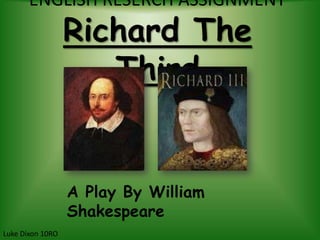
Shakespearean Charecter Study- Richard the Third
- 1. ENGLISH RESERCH ASSIGNMENT Richard The Third A Play By William Shakespeare Luke Dixon 10RO
- 2. Phase One
- 3. Background Information • Richard is the main character in the Shakespearean play; “The Tragedy Of Richard the Third”- A historic tragedy play. • The play is set in 1484 England. • The play starts with Richard displaying his envy of his elder brother [who is the ruling King of England] and the beginning of his cunning plan to become king. • Early on in the play Richard is described as a “ugly un-finished hunchback.”
- 4. Plot Synopsis • The play of “The Tragedy Of Richard The Third” follows Richard [the brother of the ruling king] through his accent to power and ultimately the king of England. He kills and imprisons many people in the fight to convince the people of England that he is the true heir to the throne and a humble content man with no want for power. Richard fights rebellions finally at the battle of Bosworth field his army abandons him and he gets killed.
- 5. Conflict The types of conflict in the play “Richard The Third” are: • Person vs. Person- Richard conflicts with people throughout the play including convincing Anne [who originally hates him] to marry him. He also conflicts with the people who stand in the way to the throne. Such as his other brother Clarence. • Person vs. Society – Richard conflicts with the Royal society as well as on a broader scale the society of England. This is because he has to remove and convince people so he can become the heir to the throne and ultimately the king of England.
- 6. Structure Outline • Exposition-The play begins with Richard describing his brothers [Henry IV] accent to the throne. This speech reveals Richards obvious jealousy of his brother. Also this uncovers his ambition to become the next in line to the throne. • Exiting Force- Richard is overcome by jealousy and begins to plot against his brother Clarence [who stands in the way of the throne] and gets him conducted to the tower of England and eventually murdered.
- 7. Structure Outline • Conflict-Richard becomes fixated on gaining power and becoming closer to the throne. The king[Henry IV] dies and leaves Richard as Lord Protector and his son as his predecessor [Henry V] • Turning Point-Richard has his nephew killed. He then puts on a false act to convince England that he is a humble man with no want for power. Richard is then announced king of England.
- 8. Structure Outline • Catastrophe-Richard loses what popularity he had throughout England and faces rebellions led by Lord Buckingham. The two armies meet at Bosworth field for a final battle. Before the battle Richard is visited by the ghost of his victims who tell him to “despair and die”. • Resolution-At the battle of Bosworth field Lord Stanley [Richards step-father] and his followers desert Richard and he is left at a severe dis-advantage. Richard is the knocked off his horse and cries “A horse a horse my kingdom for a horse” Richmond then kills Richard in the final duel.
- 9. Structure Outline • Dénouement-Richmond succeeds Richard to the throne. • Dramatic relief-Henry VII marries princess Elizabeth from the house of York and England is at peace.
- 10. Phase Two
- 11. At The Beginning • Richards relations with other characters is purely for his gains. He befriends people with more power than him to do his dirty work. For example when he persuaded the king to get rid of his other brother Clarence who stood in the way of the throne. • The main motivation that drives Richard is his want for power and the throne of England • Richard behaves towards others in a very deceitful way. He manipulates them and does this very successfully.
- 12. How He Changes • Richard influences the people around him in a bad way. He convinces and manipulates people with power to kill and imprison innocent people who stand in the way of his accent to the throne. • Richard then achieves the throne of England with killing and imprisonment to rid the throne of heirs., • Richard definitely drives the conflict in the play as he changes the normal line to the throne.
- 13. In the End • In the end of the play Richard loses what little popularity and allies he had. • This ultimately leads to his demise when he faces rebellions. He then gets deserted by some of his strong allies and loses his life
- 14. Bibliography • www.wikipedia.org/wiki/TragedyofRichardiii_[play] • www.shakespeareansinopsis.com • www.shmoop.com/richardiii/plot-analisis.html • www.shakespearonline/richardiii[play].org • www.sparknotes.com/shakespear/richardiii